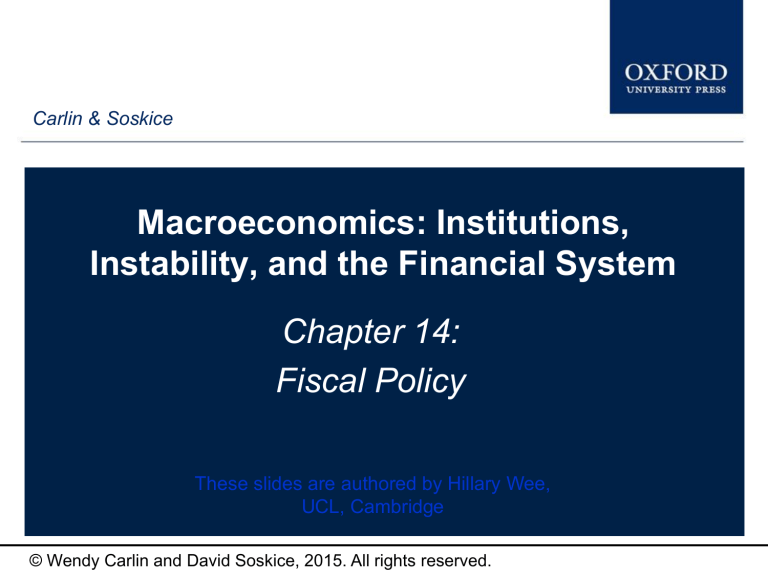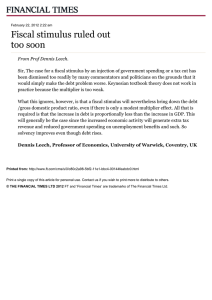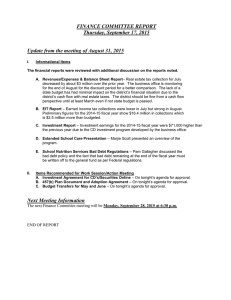
Type author
Carlin
& Soskice
names here
Macroeconomics: Institutions,
Instability, and the Financial System
Chapter 14:
Fiscal Policy
These slides are authored by Hillary Wee,
UCL, Cambridge
© Wendy Carlin and David Soskice, 2015. All rights reserved.
Objectives:
Chapter 14: Fiscal Policy
By the end of this chapter, students should understand the
following:
The role of 𝐹𝑃 in stabilization: discretionary 𝐹𝑃, the fiscal
multiplier and automatic stabilizers.
The debt dynamics model and its applications.
The government budget constraint and Ricardian Equivalence.
Deficit bias and the political economy of debt.
Carlin & Soskice: Macroeconomics: Institutions, Instability, and the Financial System
Overview:
Fiscal Policy
Discretionary 𝐹𝑃 : Key stabilization tool, if 𝑀𝑃 is constrained by ZLB.
𝐹𝑃 Automatic stabilizer: 𝐴𝐷 shock insulation to a certain extent.
𝐹𝑃 affects the public debt → ∴ ∃ downsides to discretionary 𝐹𝑃.
Ricardian equivalence & deficit bias are also studied later in Ch. 14.
Scope of 𝐹𝑃 :
Income redistribution: using taxes & transfer systems.
Resource allocation: E.g. subsidies/ taxes to particular industries
(tobacco industry etc.)
Provision of public goods: Non-excludable and non-rivalrous goods
which are not provided by the market.
Carlin & Soskice: Macroeconomics: Institutions, Instability, and the Financial System
Stabilization:
Discretionary 𝐹𝑃
Discretionary 𝐹𝑃 for stabilization:
Effectiveness depends on (1) initial state of economy, (2) model used, (3)
timescale – short or medium run.
‘The Multiplier’ of 𝐹𝑃 differs depending on the timescale.
Short-run (Keynesian) multiplier: how output changes when 𝐺 changes,
holding all else constant.
1
1 (1−𝑡)
Δ 𝑦 = 1−𝑐
Δ 𝐺 = 𝒌 Δ 𝐺,
𝒌 is the multiplier.
But general equilibrium effect of 𝐺 depends on the model (e.g. response of
𝑀𝑃) and the initial conditions of the economy.
We compare 2 different fiscal scenarios in which 𝐺 ↑ : (1) Econ. facing
severe –ve 𝐴𝐷 shock & ZLB is hit; (2) gov't wants to achieve 𝑦𝐻 > 𝑦𝑒 .
Carlin & Soskice: Macroeconomics: Institutions, Instability, and the Financial System
Stabilization:
Discretionary 𝐹𝑃
Scenario 1: Using 𝐹𝑃 for stabilization in a severe recession (Fig 14.1 a.)
Carlin & Soskice: Macroeconomics: Institutions, Instability, and the Financial System
Stabilization:
Discretionary 𝐹𝑃
(1) Deep recession:
- ve 𝐴𝐷 shock (𝐴 falls to 𝐴′) → 𝐼𝑆 shifts left → Econ moves from ‘A’ to ‘B’ .
ZLB is hit → 𝑀𝑃 does not work → Role for the 𝐹𝑃 rule (i.e. 𝑃𝑅 replaces MR ).
Now π < π𝑇 , ideal 𝑦 −gap is given by point ‘C’ (i.e. 𝑦1 ) → Gov’t increases
spending to 𝐺1 → 𝐼𝑆 shifts to 𝐼𝑆(𝐴′ , 𝐺1 ).
From ‘C’, 𝐺 is gradually reduced until the pt. ‘A’ (𝑀𝑅𝐸) is reached.
Value of multiplier > 1: Δ 𝑦 = 𝑘 Δ 𝐺
New 𝑀𝑅𝐸 :
𝑟𝑆
unchanged, but
𝐺 ′ is higher and
private autonomous
spending 𝐴′ is lower. Note: Δ 𝐺 = 𝐺 ′ − 𝐺 = (𝑦𝑒 − 𝑦0 )/𝑘 = Δ𝑦/𝑘.
Once –ve 𝐴𝐷 shock recedes (i.e. 𝐴′ rises back to 𝐴), then the fiscal stimulus
𝐺 ′ will be cut to achieve 𝑦 = 𝑦𝑒 .
Carlin & Soskice: Macroeconomics: Institutions, Instability, and the Financial System
Stabilization:
Discretionary 𝐹𝑃
2. Using 𝐹𝑃 to target an above equilibrium level of output (Fig 14.1 b.)
Carlin & Soskice: Macroeconomics: Institutions, Instability, and the Financial System
Stabilization:
Discretionary 𝐹𝑃
(2) Over-ambitious 𝑦 −target (assume 𝑀𝑃 does not interfere with 𝐹𝑃)
Initially at 𝑀𝑅𝐸 ‘A’ → 𝑃𝑅′ now goes through 𝑦𝐻 > 𝑦𝑒 instead of 𝑦𝑒 , and
target inflation is now π𝑇 ′.
To achieve desired point ‘B’, government increases spending to 𝐺1 .
‘B’ is not 𝑀𝑅𝐸 → π > π𝐸 = π𝑇 → Backward-looking π𝐸 is now updated to π𝑇 ′
→ 𝑃𝐶 shifts up next period.
Gov’t now picks desired point ‘C’ but still, 𝑦 > 𝑦𝑒 ! 𝑃𝐶 shifts up again.
Process continues until new 𝑀𝑅𝐸 ‘D’ is reached → output back to 𝑦𝑒 , but
inflation risen to π1 → Gov’t worse off than at ‘A’ → To get back to ‘A’, costs of
disinflation will have to be incurred.
Medium-run multiplier = 0. No gain in 𝑦 post-adjustment.
Carlin & Soskice: Macroeconomics: Institutions, Instability, and the Financial System
Stabilization:
The Fiscal Multiplier
Full multiplier effect depends on the model, context and CB behaviour.
If there is spare capacity, gov’t can boost 𝐴𝐷 and 𝑦 to improve welfare.
If 𝑦 = 𝑦𝑒 , expansionary 𝐹𝑃 will lead to higher π and gov’t debt, while 𝑦
will stay unchanged in the new 𝑀𝑅𝐸.
*****************************************************************************************
We assumed so far that 𝐺 is fully debt-financed. Now assume 𝐺 is fully
tax-financed (𝐺 = 𝑇), and tax is lump-sum.
Disposable income: 𝑦 𝐷 = 𝑐0 + 𝑐1 𝑦 − 𝑇 + 𝑎0 − 𝑎1 𝑟 + 𝐺
When 𝐺 changes, Δ𝑦 = Δ𝐺 + 𝑐1 Δ𝐺 + 𝑐1 𝑐1 Δ𝐺 + ⋯
𝑇 also has to increase; its impact is: Δ 𝑦 = −𝑐1 Δ 𝑇 − 𝑐1 (𝑐1 Δ 𝑇) − ⋯ [♣]
[▲]
Adding up [▲] and [♣]’s effects, and assuming Δ 𝐺 = Δ 𝑇 from 𝐺 = 𝑇 :
Δ𝑦
We get Δ 𝑦 = Δ 𝐺 , so the balanced budget multiplier = Δ 𝐺 = 𝟏.
Carlin & Soskice: Macroeconomics: Institutions, Instability, and the Financial System
Stabilization:
The Fiscal Multiplier
Balanced budget multiplier = 1 does not depend on assumption of lump sum
taxes, but on equal marginal propensity to consume for taxpayers and
providers of goods & services
{ie. 𝑐1 is the same in [♣] and [▲] }
In this case, spending power is redistributed from taxpayers to the providers of
goods and services → Aggregate consumption remains unchanged, and the
only impact on 𝑦 is the initial Δ𝐺.
Balanced budget expenditure may be useful if gov’t wants to boost 𝐴𝐷 in a
recession and is unable/ unwilling to use debt financing.
Empirical studies: No firm consensus on multiplier size; Difficult to isolate Δ𝐺 ′ 𝑠
effect from other factors.
Size depends on context: larger multiplier in developed ctys, closed economy
(lower leakages), fixed e.r. regimes; Negative multiplier in high debt ctys.
Our 3-eqn model: 𝐹𝑃 can be used to boost 𝐴𝐷 and return econ. to 𝑀𝑅𝐸 in a
recession, especially when the ZLB is hit.
Carlin & Soskice: Macroeconomics: Institutions, Instability, and the Financial System
Stabilization:
Automatic Stabilizers
Automatic stabilizers dampen shocks (𝐼𝑆 shifts less); Size of multiplier ↓ too.
Cyclically adj./ Structural budget deficit ≡ Budget deficit – Auto. stab impact
Discretionary fiscal impulse ≡ Budget deficit – Auto. stab impact
𝑮 𝒚𝒆 − 𝑻 𝒚𝒆 ≡ 𝑮 𝒚𝒕 − 𝑻 𝒚𝒕
− 𝜶(𝒚𝒆 − 𝒚𝒕 ) ,
𝑇 is taxes net of transfers.
In recession (ie. 𝑦𝑒 − 𝑦𝑡 > 0) → 𝑇 ↑ → Budget deficit 𝐺 𝑦𝑡 − 𝑇 𝑦𝑡
If 𝑦𝑡 < 𝑦𝑒 & the cyclically adj. budget deficit is zero (i.e. 𝐺 𝑦𝑒 − 𝑇 𝑦𝑒 = 0),
arises.
the actual deficit reflects auto. stabilizers, which disappear post-recession.
Auerbach & Feenberg (2000) studied the role of automatic stabilizers: Taxes
offset 8% and 𝑈-benefits 2% of any initial shock to GDP.
Fatas & Mihov (2012): Across countries, larger gov’t sector → larger auto.
stabilizers, but less discretionary 𝐹𝑃 undertaken.
Carlin & Soskice: Macroeconomics: Institutions, Instability, and the Financial System
Stabilization:
Automatic Stabilizers
UK: Primary deficit worsen during & after recessions (grey shaded areas).
Usually deficits ↑ → Debt/ GDP ↑; Also, from 1970s debt/ GDP ↓ → role of π.
Carlin & Soskice: Macroeconomics: Institutions, Instability, and the Financial System
Modelling:
Debt Dynamics
Gov’t budget identity: 𝐺𝑡 + 𝑖𝑡 𝐵𝑡−1 ≡ 𝑇𝑡 + Δ𝐵𝑡 + Δ𝑀𝑡 (in nominal terms).
gov't exp.
interest
tax
revenue
new
bonds
new
money
We want to derive the debt dynamics equation, which shows how the debt-to-
GDP ratio evolves over time: 𝜟𝒃 = 𝒅 + 𝒓 − 𝜸𝒚 𝒃. Derivations below:
1.
Abstracting from monetary financing (CB independent), 𝐺 + 𝑖𝐵−1 = 𝑇 + Δ𝐵.
2.
Rearranging this, *Δ𝐵 = 𝐺 − 𝑇 + 𝑖𝐵−1 * → Change in debt ≡ budget deficit.
3.
Define the debt ratio ≡ 𝑏 ≡
𝐵−1
𝑃𝑦
𝑏𝑢𝑑𝑔𝑒𝑡 𝑑𝑒𝑓𝑖𝑐𝑖𝑡
𝐺𝐷𝑃
&
="
Δ𝐵
𝑃𝑦
≡∗
𝐺−𝑇
𝑃𝑦
+
𝑖𝐵−1
∗
𝑃𝑦
≡ 𝑑 + 𝑖𝑏“ [▼];
𝑑 is the primary deficit/ GDP ratio.
4.
Definition: 𝐵 ≡ 𝑏𝑃𝑦 → Totally differentiating this, Δ𝐵 ≈ 𝑃𝑦Δ𝑏 + 𝑏𝑦Δ𝑃 + 𝑏𝑃Δ𝑦.
5.
Dividing this by 𝑃𝑦,
6.
Substituting RHS of [▼] into LHS of [♦] and rearranging, Δ𝑏 = 𝑑 + 𝑖 − π − 𝛾𝑦 𝑏
7.
Finally, applying the Fisher equation (𝑟 = 𝑖 − π) → "𝜟𝒃 = 𝒅 + 𝒓 − 𝜸𝒚 𝒃"
Δ𝐵
𝑃𝑦
=
𝑏Δ𝑃𝑦
𝑃𝑦
+
𝑏Δ𝑦𝑃
𝑃𝑦
+
Δ𝑏𝑃𝑦
𝑃𝑦
= 𝑏π + 𝑏𝛾𝑦 + Δ𝑏 [♦];
Carlin & Soskice: Macroeconomics: Institutions, Instability, and the Financial System
𝛾𝑦 =
Δ𝑦
𝑦
Modelling:
Debt Dynamics
𝜟𝒃 = 𝒅 + 𝒓 − 𝜸𝒚 𝒃 : 2 cases → (i) 𝒓 > 𝜸𝒚 and (ii) 𝒓 < 𝜸𝒚 .
Case 1: 𝒓 > 𝜸𝒚
(real int. rate above growth rate)
Carlin & Soskice: Macroeconomics: Institutions, Instability, and the Financial System
Modelling:
Debt Dynamics
Case 1 (𝑟 > 𝛾𝑦 ): Upward-sloping phase line → Debt to GDP ratio (𝑏) is rising
unless there is a primary budget surplus (𝑑 < 0).
Intuition: 𝑟 > 𝛾𝑦 → int. payments rising faster than GDP → Debt burden ↑;
Need primary surplus for Δ𝑏 = 0.
Fig 14.3 a.: Primary deficit → Econ. moves N.East along line → 𝑏 ↑ with each
period of a deficit.
Fig 14.3 b.: Primary surplus
•
If at ‘A’ → Surplus large enough to offset 𝑟 > 𝛾𝑦 → 𝑏 ↓ each period (Moves SWest).
•
At ‘B’ → Effect of 𝑟 > 𝛾𝑦 exactly offset by primary surplus → 𝛥𝑏 = 0 (But unstable
point → a slight deviation triggers an ever-rising/ falling 𝑏).
•
At ‘C’ → Ever-increasing debt ratio (𝑏).
Note: an appropriate primary surplus can hold 𝑏 constant but cannot mitigate
the underlying debt dynamics (determined by 𝑟 and 𝛾𝑦 ).
Carlin & Soskice: Macroeconomics: Institutions, Instability, and the Financial System
Modelling:
Case 2: 𝒓 < 𝜸𝒚
Debt Dynamics
(real int. rate below growth rate)
Carlin & Soskice: Macroeconomics: Institutions, Instability, and the Financial System
Modelling:
Debt Dynamics
Case 2 (𝑟 < 𝛾𝑦 ): Growth of econ. sufficient to reduce impact of int. payments
on the debt burden → ∴ Some primary deficit is consistent with Δ𝑏 = 0.
Fig 14.4 a.: At ‘C’, debt ratio is rising (Economy moves S.East) → when ‘B’ is
reached, 𝛥𝑏 = 0 (Stable point → Econ. moves back to ‘B’ after any deviation)
Fig 14.4 b.: Primary surplus, gov’t will end up with negative public debt (𝑏 < 0,
Gov’t is a net holder of private sector financial assets).
Comparing Stable & Unstable Equilibria – points ‘B’ in Fig 14.3 b. and 14.4 a.
Fig 14.3 b.: 𝑟 > 𝛾𝑦 → when there is a small increase in 𝑏, the interest burden
of debt reinforces the increase in 𝑏. (unstable equilibrium)
Fig 14.4 a.: 𝑟 > 𝛾𝑦 → the increase in 𝑏 is dampened because 𝑦 grows faster.
(stable equilibrium)
Carlin & Soskice: Macroeconomics: Institutions, Instability, and the Financial System
Modelling:
Debt Dynamics
Scenario analysis – Fig. 14.5 a. (below):
Initially at ‘A’, primary deficit (𝑑 > 0) and 𝑟 < 𝛾𝑦 .
But shock to 𝑟 and/or 𝛾𝑦 → now, 𝑟 < 𝛾𝑦 → New upward-sloping phase line →
Economy jumps to ‘B’ → 𝑏 rises without limit unless 𝑟, 𝛾𝑦 or 𝑑 changes.
Carlin & Soskice: Macroeconomics: Institutions, Instability, and the Financial System
Modelling:
Debt Dynamics
Fig 14.5 b. (below): 𝐹𝑃 shifts.
Same as before, but as soon as 𝑟 < 𝛾𝑦 occurs, gov't tightens 𝑭𝑷 (↑ 𝑇 and/ or ↓ 𝐺)
→ If tightening is instantaneous, econ. moves from ‘A’ to ‘C’ and 𝒃 will be
constant (but unstable).
Carlin & Soskice: Macroeconomics: Institutions, Instability, and the Financial System
Modelling:
Debt Dynamics
Sovereign default risk:
Positive default risk premium (𝜌) s.t. 𝒓 = 𝒓𝒓𝒊𝒔𝒌−𝒇𝒓𝒆𝒆 + 𝝆
Thus, Δ𝑏 = 𝑑 + (𝑟 𝑟𝑖𝑠𝑘−𝑓𝑟𝑒𝑒 + 𝜌 − γ𝑦 )𝑏 → Debt dynamics is worsened by 𝜌.
Inflation and gov’t debt:
Link between π and 𝑏 : 𝜟𝒃 = 𝒅 + 𝒊 − 𝝅 − 𝜸𝒚 𝒃 → π reduces Δ𝑏
Causality can go both ways: (i) For a given debt level, higher inflation reduces it
(ii) Higher inflation may be a policy response to reduce the higher debt burden.
Costs of high and rising gov't debt:
Costs are high if 𝑟 > 𝛾𝑦 → larger surplus needed → problems: painful cuts in 𝐺;
𝑇 ↑ might lead to negative supply-side effects (𝑃𝑆 shifts down – see Ch. 15).
Rising debt may trigger concerns of gov’t default → 𝜌 ↑ → 𝑟 ↑ → debt burden ↑,
investment dampened. Credit to gov’t may be cut off too.
Carlin & Soskice: Macroeconomics: Institutions, Instability, and the Financial System
Modelling:
Debt Dynamics
Previously assumed 𝑟 and γ𝑦 as exogenous → Now, potential feedback from the
debt ratio (𝑏) into borrowing costs (𝑟) via increased default risk (𝜌).
Even if 𝑟 < 𝛾𝑦 , large 𝑏 is still a concern → If suddenly 𝑟 > 𝛾𝑦 , greater fiscal
tightening needed to stem the rise in 𝑏; Risk premium may also arise due to large
𝑏.
Condition for gov’t solvency & for the absence of default risk: Non-increasing debt
ratio (Δ𝑏 ≤ 0), assuming 𝑏 > 0 :
𝛥𝑏 = 𝑑 + 𝑟 − 𝛾𝑦 𝑏 ≤ 𝟎 implies 𝒃 ≤
−𝒅
𝒓−𝜸𝒚
(╬) i.e. 𝐷𝑒𝑏𝑡 𝐺𝐷𝑃 ≤
𝑝𝑟𝑖𝑚𝑎𝑟𝑦 𝑠𝑢𝑟𝑝𝑙𝑢𝑠 𝐺𝐷𝑃
𝑟−𝛾𝑦
Interpret each variable in terms of its long-run value. (╬) says that for long-run
sustainability, if the long-run int. rate is larger than the long-run growth rate
(denominator >0), then a long-run primary surplus (𝑑 < 0 thus numerator >0) is
needed for the debt ratio to stay constant.
(Note: RHS needs to be large enough for (╬) to hold )
Carlin & Soskice: Macroeconomics: Institutions, Instability, and the Financial System
Application:
Debt Dynamics
Eurozone sovereign debt crisis: Δ𝑏 > 0 btw 2008-11. We can explain this using
Δ𝑏 = 𝑑 + (𝑟 𝑟𝑖𝑠𝑘−𝑓𝑟𝑒𝑒 + 𝜌 − γ𝑦 )𝑏 → For Δ𝑏 > 0, we simply need RHS>0.
𝑑 > 0 from bailing out banks; γ𝑦 ↓ from collapsed 𝐴𝐷 due to the global fin. crisis;
𝜌 ↑ from fears of default in the periphery.
Even gov’ts with low
& stable 𝑏 are
vulnerable to 𝑟 > 𝛾𝑦 .
E.g. debt explosion in
Ireland (25% in 2007
to 108% by 2011)
Carlin & Soskice: Macroeconomics: Institutions, Instability, and the Financial System
Application:
Debt Dynamics
Empirical relation between high debt & GDP growth
Reinhart & Rogoff (2010): Periods when gov't Debt/GDP exceeded 90% were
associated with ~1% lower annual growth → used to justify austerity in the EU.
Problems with R&R: 1. Spreadsheet errors which overestimated –ve relation
btw debt/GDP ratio and high debt; 2. Possible reverse causality (i.e. slow
growth causing debt build-up).
Instrumental variables & distributed lag models were used to disentangle
causality, but the literature has yet to come to a consensus.
Can fiscal consolidation (𝐹𝐶) be expansionary?
Assumed so far that primary surplus reduces s/run 𝐴𝐷 & 𝑦 (𝐼𝑆 shifts left).
But fiscal consolidation can stimulate 𝐴𝐷 if econ. is in a state of ‘fiscal stress’
(an unsustainable fiscal position) → 𝜌 & gov't borrowing costs high.
Carlin & Soskice: Macroeconomics: Institutions, Instability, and the Financial System
Application:
Debt Dynamics
Moreover during fiscal stress, 𝐶 & 𝐼 ↓ due to expectations of crisis (↓ H/hold
wealth) & econ. uncertainty → ∴ Credible fiscal consolidation may boost 𝐶 & 𝐼.
Composition of 𝐹𝐶, not just size matters: e.g. ↓ 𝐺 more credible in signaling
l/term commitment to fiscal reform than ↑ 𝑇 → Boosts priv. expectations more.
IMF (2010) findings:
1. Fiscal consolidation is typically contractionary
2. Pain of consolidation is eased by accommodative 𝑀𝑃, e.r. depreciation and
larger reliance on spending cuts than tax rises.
3. Consolidations are less contractionary in countries with high perceived
default risk, but expansionary effects are still unusual.
Consolidation will be most painful under fixed e.r. (e.g. Eurozone economies!)
and when there is little scope for monetary stimulus such as at the ZLB
Carlin & Soskice: Macroeconomics: Institutions, Instability, and the Financial System
Modelling:
Ricardian Equivalence
Ricardian Equivalence – Permanent Income Hypothesis (RE–PIH)
gov't deficit and tax financing of spending are equivalent to h/holds, given
these conditions:
1.
No credit-constrained h/holds, able to borrow at prevailing int. rate (PIH)
2.
Interest rates & time horizon faced by h/holds & gov't are equivalent.
3.
H/holds behave as if they are infinitely-lived (e.g. children’s utility incorporated in 𝐶)
∞ 𝑦𝑡+𝑖 −𝑇𝑡+𝑖
𝑖=0 (1+𝑟)𝑖
𝐶𝑡+𝑖
∞
𝑖=0 (1+𝑟)𝑖 .
H/holds maximize utility s.t. intertemporal b/c :
Under full tax-financing (𝑇 = 𝐺 ∀ periods) and ρ = 𝑟 (Same 𝐶 ∀ periods),
=
h/holds consume their permanent income, 𝑦𝑒 − 𝑇 = 𝑦𝑒 − 𝐺 ∀ periods (Ch. 1).
Under full debt-financing (𝐵 = 𝐺 ∀ periods), gov't needs to raise 𝑇 to pay off
interest bill when due (𝑟𝐵 in period 1, 2𝑟𝐵 in period 2, …, 𝑡𝑟𝐵 in period 𝑡 …).
So, disposable income in period 𝑡 is 𝑦𝑒 − 𝑡𝑟𝐵, ∀ 𝑡 = 0,1, … ∞. If h/holds want
to consume the same 𝐶 ∀ period, they need to save 𝑩 each period to pay off
future taxation (Total future 𝑇 equals to the sum of 𝐵 across all periods!)
Carlin & Soskice: Macroeconomics: Institutions, Instability, and the Financial System
Modelling:
Ricardian Equivalence
∴ 𝐶 = 𝑦𝑒 − 𝐵 = 𝑦𝑒 − 𝐺 = 𝑦𝑒 − 𝑇 (same as under 𝑇-financing!)
Under RE–PIH, h/hold do not increase 𝐶 for period 0 when they have higher
disposable income (due to the debt-financing as opposed to tax-financing).
Why the assumptions of RE–PIH do not hold:
1.
Credit constraints: Consumption smoothing absent; Higher 𝑦 𝑑𝑖𝑠𝑝 increases 𝐶.
2.
Gov't has lower int. rate: H/holds prefer debt-financing (cheaper) over tax-financing.
3.
H/holds do not behave as if they are ∞-lived: e.g. No bequest to children.
But financial market development found to strengthen Ricardian effects, and
the world economy may be become more Ricardian.
Implications of RE–PIH on 𝐹𝑃 effectiveness:
Temporary tax cut → implies 𝑇 ↑ later → 𝑇 cut is saved 𝐶↓, 𝐴𝐷 unchanged!
Temporary rise in 𝐺, debt-financed → 𝑦𝑒 ↓ but cut in 𝐶 spread across all
periods → Fall in 𝐶 < Rise in 𝐺 → 𝐴𝐷 ↑ in period 0, ceteris paribus.
Temporary rise in 𝐺, tax-financed (same as above by RE–PIH)
Carlin & Soskice: Macroeconomics: Institutions, Instability, and the Financial System
Application:
Deficit Bias
Deficit bias: The tendency for budget deficit to rise during recessions but not
fall sufficiently in booms → gov't preference of debt- over tax-financing.
Causes of deficit bias:
1.
Over-ambitious output target: targeting 𝑦𝐻 > 𝑦𝑒 results in 𝑀𝑅𝐸 with inflation bias
and higher gov't debt (see Fig 14.1 b; slide 7-8).
2.
Uncertainty about growth forecasts: over-optimistic forecasts of γ𝑦 produces higher
forecasts of tax revenue which may lead to 𝐹𝑃 which increases 𝑏.
3.
Intergenerational conflict: e.g. if current fiscal policy places too low a weight on
higher future spending due to an ageing population.
Factors explaining deficit bias variation across countries:
1.
Different preferences for public goods: e.g. in Scandinavia where public goods are
highly valued, voters vote to restrict 𝐺 & 𝑏, to secure the future public good supply
2.
Right wing gov’ts incur deficits (↓ 𝑇) so that it is harder for left gov’ts to ↑ 𝐺 later.
3.
Failure of 𝐹𝑃 to fully internalize costs to the future budget when ↑ 𝐺/ ↓ 𝑇 benefit
particular groups in the economy.
Carlin & Soskice: Macroeconomics: Institutions, Instability, and the Financial System
Application:
Deficit Bias
Tackling deficit bias: (i) Fiscal rules:
Prudent 𝐹𝑃 Rules:
For Δ𝑏 ≤ 0 , need
𝑻 𝒚 = 𝑻 𝒚
𝑷
≥ (𝑮 𝒚)𝑷 + 𝒓𝑷 − 𝜸𝑷
𝒚 𝒃
𝑃 refers to permanent or l/run value. Some implications of the PFPR:
1.
A permanent rise in 𝐺 should be financed by 𝑇
2.
A temporary rise in 𝐺 should be financed through borrowing
3.
Major gov't infrastructure spending which will take 𝐺 above its permanent level for many
years should be financed through borrowing
4.
Borrowing should be permitted to rise if 𝑟 > 𝛾𝑦 is temporary.
5.
𝐺 must be reduced below its permanent level in upswings. Averaged over the cycle, there
should be no divergence between 𝐺 𝑦 and (𝐺 𝑦)𝑃 .
PFPR advocates tax smoothing (≈ consumption smoothing) since taxes are distortionary
→ Temporary shocks to 𝐺 are dealt with by borrowing, so that 𝑇 𝑦 is constant.
𝐹𝑃 rules in practice: the SGP in Europe (different from PFPR).
SGP did not allow for adequate stabilizations in a deep recession, limits the use of 𝐺 for
l/run infrastructure projects and still did not discourage pro-cyclical 𝐹𝑃 (destabilizing).
Carlin & Soskice: Macroeconomics: Institutions, Instability, and the Financial System
Application:
Deficit Bias
Tackling deficit bias: (ii) Fiscal policy councils (FPCs):
Independent fiscal watchdog to make sure 𝐹𝑃 is sustainable over the l/term.
3 main reasons for the re-emergence of independent FPCs to limit deficit bias:
1. The success of independent 𝜋- targeting CBs during the 1990s & 2000s.
2. Fiscal rules were insufficient to ensure prudent management of public finances.
3. FPCs boost the credibility of consolidation/ austerity packages & act as a
commitment device to governments.
Examples of FPC mandates: Performing forecasts, positive policy analysis
(assessing fiscal costs etc.) and making normative recommendations of 𝐹𝑃.
However, FPCs do not have power to set 𝐹𝑃 as a CB would set 𝑀𝑃.
𝑀𝑃 is more neutral but 𝐹𝑃 is inherently political (many ‘policy levers’ which
generates disproportionate effects on certain groups- e.g. rich & the poor).
FPCs are likely to become more visible & influential given that fiscal consolidation
& public finance sustainability is a now central to macro policy debates.
Carlin & Soskice: Macroeconomics: Institutions, Instability, and the Financial System
Summary:
Chapter 14: Fiscal Policy
The effects of discret. 𝐹𝑃 & the multiplier depend on initial conditions & the model
There are impt. roles for discret. 𝐹𝑃 (e.g. when ZLB is hit) & also auto. stabilizers
The debt dynamics model shows the evolution of gov't debt over time, which
depends on the primary deficit, 𝑟 − 𝛾𝑦 and the existing debt level (𝑏)
Reducing 𝑑 by austerity can reduce 𝑏 but this may damage economic growth
So far, there is no consensus on the expansionary effects of consolidation.
Ricardian equivalence states that under certain conditions, the consumption
response to a tax- or borrowing-financed change in 𝐺 is the same
Under this, temporary fiscal stimuli based on ↓ 𝑇 has no effect while a temporary
↑ 𝐺 increases 𝑦 in the current period
Deficit bias leads to a preference for debt financing over tax financing
It may be caused by 𝑦𝐻 > 𝑦𝑒 , uncertainty over γ𝑦 & intergenerational conflicts
This problem can be addressed by fiscal rules and fiscal policy councils
Carlin & Soskice: Macroeconomics: Institutions, Instability, and the Financial System





